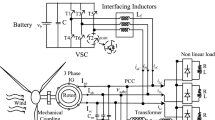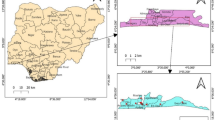Abstract
This paper represents an arrangement of fuzzy PD and derivative filter based PID controller (FPIDF) with its optimally designed membership functions and is employed for the load frequency control (LFC) of isolated multi- microgrids. The performance of a recently developed multi verse optimizer (MVO) algorithm is improved by introducing chaotic map appropriately in the algorithm. The improved algorithm, named as CMVO algorithm is applied to tune the proportional integral derivative (PID) controller gains for the LFC of microgrid. The superiority of the proposed CMVO algorithm is examined by its superior performance compared to MVO PID, recently published IAYA PID, JAYA PID and GA PID in the microgrid system. Further, CMVO based FPIDF with its optimized membership position (FPIDF-OM) outperforms compared to CMVO based FPIDF, IJAYA tuned FPID and FPD/PI-PD controller in microgrid system. Better dynamic performances are found with the proposed technique for stochastic type wind power, solar irradiance and load variations in the microgrid compared with FPIDF and PID. The robustness of the proposed technique is established by the sensitivity analysis. The proposed design approach has been extended to a microgrid model including biogas turbine generator, biodiesel engine generator and aqua electrolyser along with fuel cell unit. Finally, OPAL-RT based hardware-in-the-loop simulation of proposed techniques has been done.














Similar content being viewed by others
Abbreviations
- i:
-
Subscript referring to area-i (i = 1,2)
- Ri :
-
Speed regulation constant (p.u.)
- Bi :
-
Frequency bias constant (p.u.)
- KTi, TTi :
-
Gain(p.u.) and time(s) constants of turbine, respectively
- KGi, TGi :
-
Gain(p.u.) and time(s) constants of speed governor, respectively
- KWTi, TWTi :
-
Gain(p.u.) and time(s) constants of wind turbine (WT) unit, respectively
- KPVi, TPVi :
-
Gain(p.u.) and time(s) constants of photovoltaic(PV) unit, respectively
- KBESSi, TBESSi :
-
Gain(p.u.) and time(s) constants of battery energy storage system(BESS) unit, respectively
- KFESSi, TFESSi :
-
Gain(p.u.) and time(s) constants of flywheel energy storage system(FESS) unit, respectively
- Mi :
-
Inertia constant (p.u.)
- Di :
-
Damping constant (p.u.)
- T12 :
-
Synchronizing coefficient
- T CR, T BG, Xc, Yc, b B,TBT :
-
Biogas turbine generator (BGTG) unit’s combustion reaction delay, biogas delay, lead time, lag time, valve actuator and discharge time constants respectively
- K VA, T VA, K BE, T BE :
-
Biodiesel engine generator (BDEG) unit’s valve gain, valve actuator delay, engine gain and time constants respectively
- K AEi, T AEi :
-
Gain(p.u.) and time (s) constants of Aqua electrolyser (AE) unit, respectively
- K FCi, T FCi :
-
Gain(p.u.) and time (s) constants of Fuel cell (FC) unit, respectively
- P n :
-
Fraction of WT and PV power
- Pf1, Pf2 :
-
Participation factors of BGTG and BDEG respectively.
- ∆PLi :
-
Incremental change in load power demand in area-i
- ∆Fi, ∆PTie :
-
System frequency and tie line power deviation (p.u.), respectively
- PPVi, PWTi :
-
Power generated from PV and WT (p.u.) respectively
- m :
-
Number of objects(variables to be optimized) in Multi Verse Optimizer (MVO)/Chaotic MVO (CMVO) algorithm
- n :
-
Number of universes (solutions) in MVO/CMVO algorithm
- U:
-
Matrix of size (n × m) for random populations
- \({{u}_{i}}^{j}\) :
-
Element of U representing jth parameter of ith universe,(i = 1 to n, j = 1 to m)
- \(NI(Ui): \mathrm{n}\mathrm{o}\mathrm{r}\mathrm{m}\mathrm{a}\mathrm{l}\mathrm{i}\mathrm{z}\mathrm{e}\mathrm{d} \mathrm{i}\mathrm{n}\mathrm{f}\mathrm{l}\mathrm{a}\mathrm{t}\mathrm{i}\mathrm{o}\mathrm{n} \mathrm{r}\mathrm{a}\mathrm{t}\mathrm{e}\) :
-
ith universe
- \({{u}_{k}}^{j}\) :
-
jth Parameter of kth universe (chosen by roulette wheel selection method)
- T:
-
Maximum time(maximum number of iterations)
- t :
-
Current time (Current iteration)
- \({u}_{j}^{*}\) :
-
jth Parameter of the fittest solution u*obtained so far
- \({\mathrm{l}\mathrm{l}}_{\mathrm{j} },{\mathrm{u}\mathrm{l}}_{\mathrm{j}}\) :
-
Lower and upper limit of jth variable
- \({\mathrm{W}\mathrm{E}\mathrm{P}}_{\mathrm{m}\mathrm{i}\mathrm{n}} ,{ \mathrm{W}\mathrm{E}\mathrm{P}}_{\mathrm{m}\mathrm{a}\mathrm{x}}\) :
-
Minimum and maximum value of wormhole existence probability (WEP), respectively
- sp :
-
Parameter signifies the speedy and precision of local search over the cycles
- \({c}_{t}\) :
-
Random number generated by Chebyshev map in CMVO algorithm
- c0 :
-
Initial value in Chebyshev map
- \({TDR}_{C}\) :
-
Travelling distance rate (TDR) value modified by Chebyshev map
References
Bevrani H, Habibi F, Babahajyani P, Watanabe M, Mitani Y (2012) Intelligent frequency control in an AC microgrid: online PSO-based fuzzy tuning approach. IEEE Trans Smart Grid 4:1935–1944
Pan I, Das S (2014) Kriging based surrogate modeling for fractional order control of microgrids. IEEE Trans Smart Grid 6(1):36–44
Şerban I, Marinescu C (2011) Aggregate load-frequency control of a wind-hydro autonomous microgrid. Renewable Energy 36(12):3345–3354
Lasseter RH, Piagi P (2004) Microgrid: a conceptual solution. IEEE Power Electron Spec Conf 6:4285–4291
Yang J, Zeng Z, Tang Y, Yan J, He H, Wu Y (2015) Load frequency control in isolated micro-grids with electrical vehicles based on multivariable generalized predictive theory. Energies 8(3):2145–2164
Chowdhury AH, Asaduz-Zaman M (2014) Load frequency control of multi-microgrid using energy storage system. In: 8th IEEE international conference on electrical and computer engineering. pp. 548–551.
Kargarian A, Rahmani M (2015) Multi-microgrid energy systems operation incorporating distribution-interline power flow controller. Electric Power Syst Res 129:208–216
Khalghani MR, Khooban MH, Mahboubi-Moghaddam E, Vafamand N, Goodarzi M (2016) A self-tuning load frequency control strategy for microgrids: Human brain emotional learning. Int J Electr Power Energy Syst 75:311–319
Khooban MH (2017) Secondary load frequency control of time-delay stand-alone microgrids with electric vehicles. IEEE Trans Industr Electron 65(9):7416–7422
Dehghani M, Khooban MH, Niknam T, Rafiei SM (2016) Time-varying sliding mode control strategy for multibus low-voltage microgrids with parallel connected renewable power sources in islanding mode. J Energy Eng 142(4):05016002
Goya T, Omine E, Kinjyo Y, Senjyu T, Yona A, Urasaki N, Funabashi T (2011) Frequency control in isolated island by using parallel operated battery systems applying H∞ control theory based on droop characteristics. IET Renew Power Gener 5(2):160–166
Khooban MH, Niknam T, Blaabjerg F, Davari P, Dragicevic T (2016) A robust adaptive load frequency control for micro-grids. ISA Trans 65:220–229
Das DC, Roy AK, Sinha N (2012) GA based frequency controller for solar thermal–diesel–wind hybrid energy generation/energy storage system. Int J Electr Power Energy Syst 43(1):262–279
Mahto T, Mukherjee V (2016) Evolutionary optimization technique for comparative analysis of different classical controllers for an isolated wind–diesel hybrid power system. Swarm Evolut Comput 26:120–136
El-Fergany AA, El-Hameed MA (2017) Efficient frequency controllers for autonomous two-area hybrid microgrid system using social-spider optimiser. IET Gener Transm Distrib 11(3):637–648
Sahoo BP, Panda S (2018) Improved grey wolf optimization technique for fuzzy aided PID controller design for power system frequency control. Sustain Energy Grids Netw 16:278–299
Sahu RK, Panda S, Yegireddy NK (2014) A novel hybrid DEPS optimized fuzzy PI/PID controller for load frequency control of multi-area interconnected power systems. J Process Control 24(10):1596–1608
Sahu RK, Panda S, Pradhan PC (2015) Design and analysis of hybrid firefly algorithm-pattern search based fuzzy PID controller for LFC of multi area power systems. Int J Electr Power Energy Syst 69:200–212
Khooban MH, Dragicevic T, Blaabjerg F, Delimar M (2017) Shipboard microgrids: a novel approach to load frequency control. IEEE Trans Sustain Energy 9(2):843–852
Khooban MH, Niknam T, Blaabjerg F, Dragičević T (2017) A new load frequency control strategy for micro-grids with considering electrical vehicles. Electric Power Syst Res 143:585–598
Khooban MH, Niknam T, Shasadeghi M, Dragicevic T, Blaabjerg F (2017) Load frequency control in microgrids based on a stochastic noninteger controller. IEEE Trans Sustain Energy 9(2):853–861
Gheisarnejad M, Khooban MH (2019) Secondary load frequency control for multi-microgrids: HiL real-time simulation. Soft Comput 23:5785–5798
Tarkeshwar M, Mukherjee V (2015) Quasi-oppositional harmony search algorithm and fuzzy logic controller for load frequency stabilisation of an isolated hybrid power system. IET Gener Transm Distrib 9(5):427–444
Wolpert DH, Macready WG (1997) No free lunch theorems for optimization. IEEE Trans Evol Comput 1(1):67–82
Xiong G, Zhang J, Shi D, He Y (2018) Parameter extraction of solar photovoltaic models using an improved whale optimization algorithm. Energy Convers Manage 174:388–405
Arora S, Anand P (2019) Binary butterfly optimization approaches for feature selection. Expert Syst Appl 116:147–160
Mafarja MM, Mirjalili S (2017) Hybrid Whale Optimization Algorithm with simulated annealing for feature selection. Neuro Comput 260:302–312
Khadanga RK, Kumar A (2016) Hybrid adaptive ‘gbest’-guided gravitational search and pattern search algorithm for automatic generation control of multi-area power system. IET Gener Transm Distrib 11(13):3257–3267
Jangir P, Parmar SA, Trivedi IN, Bhesdadiya RH (2017) A novel hybrid particle swarm optimizer with multi verse optimizer for global numerical optimization and optimal reactive power dispatch problem. Int J Eng Sci Technol 20(2):570–586
Kaur G, Arora S (2018) Chaotic whale optimization algorithm. J Comput Des Eng 5(3):275–284
Kohli M, Arora S (2018) Chaotic grey wolf optimization algorithm for constrained optimization problems. J Comput Des Eng 5(4):458–472
Arora S, Singh S (2015) Butterfly algorithm with levy flights for global optimization. In IEEE international conference on signal processing, computing and control (ISPCC), pp. 220–224
Gandomi AH, Yang XS (2014) Chaotic bat algorithm. J Comput Sci 5(2):224–232
Mirjalili S, Mirjalili SM, Hatamlou A (2016) Multi-verse optimizer: a nature-inspired algorithm for global optimization. Neural Comput Appl 27(2):495–513
Elgerd OI (2007) Electric energy systems theory: an introduction. Tata Mc-Graw Hill, New Delhi
Chowdhury AH, Asaduz-Zaman M (2014) Load frequency control of multi-microgrid using energy storage system. In 8th IEEE international conference on electrical and computer engineering, pp 548–551
Barik AK, Das DC (2018) Expeditious frequency control of solar photovoltaic/biogas/biodiesel generator based isolated renewable microgrid using grasshopper optimisation algorithm. IET Renew Power Gener 12(14):1659–1667
Gheisarnejad, M., Khooban, M. H., & Dragicevic, T. (2019). The future 5G network based secondary load frequency control in maritime microgrids. IEEE J Emerg Sel Top Power Electron
Pecora LM, Carroll TL (1990) Synchronization in chaotic systems. Phys Rev Lett 64(8):821
Saremi S, Mirjalili S, Lewis A (2014) Biogeography-based optimisation with chaos. Neural Comput Appl 25(5):1077–1097
Acknowledgements
The authors would like to thank Electrical Engineering department, Veer Surendra Sai University of Technology, Burla, Odisha, India for facilitating their Computational Laboratory for conducting OPAL-RT based HIL real time simulation.
Author information
Authors and Affiliations
Corresponding author
Additional information
Publisher's Note
Springer Nature remains neutral with regard to jurisdictional claims in published maps and institutional affiliations.
Appendices
Appendix 1: Nominal values of the system investigated [22, 37, 38]
System parameter | Value | System parameter | Value |
|---|---|---|---|
R1 | 0.05 | Di | 1 |
R2 | 0.04 | T12 | 1.4 |
B1 | 10 | T BG | 0.23 s |
B1 | 12.5 | T CR | 0.01 s |
TTi | 0.4 | Xc | 0.6 |
TGi | 0.1 | Yc | 1 s |
TWTi | 0.5 | b B | 0.05 |
TPVi | 1.5 | TBT | 0.2 s |
TBESSi | 0.1 | K VA | 1 |
TFESSi | 0.1 | T VA | 0.05 s |
KTi | 1 | K BE | 1 |
KGi | 1 | T BE | 0.5 s |
KBESS1 | − 3 | K AEi | 0.002 |
KBESS2 | − 4 | K FCi | 1/50 |
KFESS1 | − 1.5 | T AEi | 0.5 s |
KFESS1 | − 2 | T FCi | 4 s |
KWTi | 1 | P n | 0.6 |
KPVi | 1 | Pf1 | 0.75 |
Mi | 8 | Pf2 | 0.25 |
Appendix 2
Pseudo code of CMVO algorithm

Rights and permissions
About this article
Cite this article
Sahoo, B.P., Panda, S. Chaotic multi verse optimizer based fuzzy logic controller for frequency control of microgrids. Evol. Intel. 14, 1597–1618 (2021). https://doi.org/10.1007/s12065-020-00405-9
Received:
Revised:
Accepted:
Published:
Issue Date:
DOI: https://doi.org/10.1007/s12065-020-00405-9




